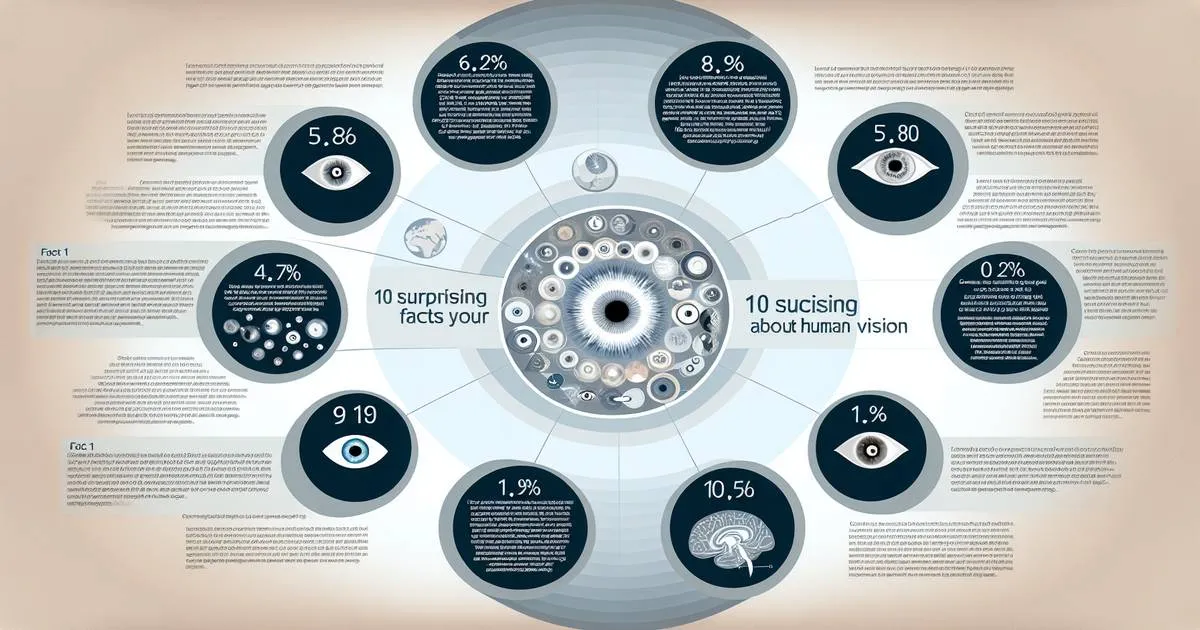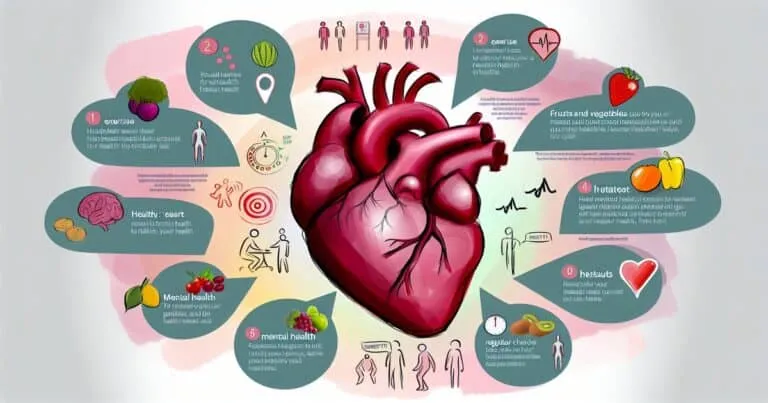Eye Facts: 10 Surprising Truths About Human Vision
Eyes are not just windows to the soul; they’re fascinating biological wonders with secrets waiting to be discovered. From their unique colors to the incredible way they work, eye facts never cease to amaze. Imagine being able to see a world beyond what you thought was possible, unlocking mysteries hidden in plain sight. That’s exactly what we’re diving into today – a collection of mind-blowing truths about our eyes that will change how you view…well, everything! So, if you’re eager for some eye-opening revelations, scroll down as we unveil our top picks of astonishing eye facts.
1. The human eye can distinguish approximately 10 million colors.
Our eyes are like super-powered cameras that can see a rainbow of colors. They do this by mixing red, green, and blue light. Think of it as being similar to how a computer screen works to show you pictures and videos.
Color perception is fascinating because not everyone sees colors the same way. Some people have color blindness, which means they might mix up certain colors or can’t see them at all. It’s like when two friends argue whether something is blue or green; sometimes, what one person sees isn’t what the other does.
Animals have a different view of the world compared to humans. Many animals see fewer colors than we do because their eyes don’t mix lights in the same way ours do. Imagine if your whole world was just shades of grey and yellow! That’s how some animals see things.
Here are some interesting facts about our ability to perceive colors:
- The human eye has three types of cones (tiny cells) for detecting color.
- These cones let us recognize around 10 million different hues.
- Despite this amazing ability, we often struggle with distinguishing subtle differences between similar shades.
2. Eyes heal quickly, with corneal scratches healing within 48-72 hours.
Eyes are amazing at healing themselves, especially the cornea. This part of your eye is the fastest healing tissue in the human body. When you get a minor scratch on it, most times, you won’t even need medicine to fix it.
Minor injuries like small scratches often heal on their own within 48-72 hours. That’s super quick compared to other parts of your body! The secret behind this rapid healing? Our tears play a big role. They’re not just for crying when we’re sad or chopping onions. Tears have special powers that help protect and heal our eyes faster.
Tears contain enzymes and proteins that fight off infections and speed up the healing process. So next time you blink away those droplets, remember they’re doing much more than keeping your eyes wet; they’re acting as natural healers.
In cases where you might think a scratch is no big deal because of how quickly eyes can heal, always be cautious. If something feels wrong or if there’s pain beyond what seems normal for a minor injury, seeing an eye doctor is wise.
3. Newborn babies don’t produce tears until they are about one to three months old.
When newborns cry, you might notice they do so without shedding a single tear. This isn’t because they’re holding back; their tear ducts are simply not fully developed at birth. It takes about one to three months for these ducts to mature enough to produce tears.
The role of tears goes beyond just a signal of distress or discomfort. They serve as a protective layer for the eyes, keeping them moist and washing away foreign particles that could cause infections. Without this natural defense mechanism, babies’ eyes are more vulnerable to irritants and bacteria.
Interestingly, while babies may not produce visible tears right away, their bodies are still preparing the necessary tools for eye protection from day one. The development of tear ducts is a fascinating process that begins in the womb but only completes its course after birth.
4. The eye is the fastest muscle in the human body, hence why we say “in the blink of an eye”.
Blinking is not just a simple movement; it’s an essential function for keeping our eyes healthy. Every time we blink, our eyelids spread moisture across the surface of our eyes. This action cleans away dust and debris while also providing essential hydration to prevent dryness.
But blinking has another crucial role – protection. Reflex blinks jump into action when unexpected objects come too close or when bright lights threaten to damage our vision. It’s like having a built-in shield that automatically guards our eyes from potential harm.
Interestingly, the digital age has impacted how often we blink. When glued to screens, whether it’s smartphones, computers, or TVs, we tend to blink significantly less. Normally, humans blink around 15-20 times per minute. However, studies show that this number can halve while focusing on digital screens. This reduction in blinking rate can lead to eye strain and discomfort because the eyes are not being moisturized as frequently as they should be.
Eyelashes play their part too by acting as sensors that trigger reflex blinks when they detect objects coming too close to the eye or when particles touch them.
5. Your eyes can get sunburned, a condition known as photokeratitis.
Believe it or not, just like your skin, your eyes can also get sunburned. This eye condition is called photokeratitis and it happens when you expose your eyes to too much ultraviolet (UV) light from the sun.
The main culprit behind this uncomfortable condition is UV light. When your eyes are exposed to too much of it, especially without protection, they can suffer from what’s essentially a burn. It’s not something you want to experience!
If you’ve ever had photokeratitis, you’d know the symptoms are no walk in the park. They include pain that feels sharp or gritty in your eyes and blurred vision which makes everything look foggy. Imagine trying to see through a smeared window; that’s how things might appear.
But here’s some good news: protecting your eyes from getting sunburned is pretty straightforward. Sunglasses are more than just a fashion accessory; they’re essential for maintaining good eye health. When buying sunglasses:
- Look for ones that block out 99% to 100% of both UVA and UVB rays.
- Ensure they cover enough area around your eyes to prevent sunlight from entering.
6. Each of your eyes has a small blind spot in the back of the retina where the optic nerve attaches.
In the back of your eye, there’s a spot that doesn’t see light. This is because it’s where the optic nerve attaches to the retina. Since there are no light-sensitive cells in this area, we call it a blind spot.
But here’s where things get interesting. Even though each eye has a blind spot, you don’t notice them in your daily life. Why? Because your brain is pretty smart! It uses the information from both eyes to fill in these gaps, so you see a complete picture.
If you’re curious about finding your own blind spots, there’s an easy test you can do. Cover one eye and focus on a single point ahead. Move slightly or change what you’re looking at until something disappears from view—that’s your blind spot!
This phenomenon shows just how complex our bodies are, especially.
7. Eyes use about 65% of your brainpower, more than any other part of the body.
Processing visual information is no small feat for the brain. It’s a complex task that requires about 65% of your brainpower, more than any other part of your body. This high percentage underscores just how vital vision is to humans.
The eye might seem like a simple organ at first glance, but it works closely with the brain to help us understand the world around us. When you see something, light hits your eyes and turns into signals. These signals then travel to various parts of your brain to be processed into images. This process involves multiple areas and countless cells working together in harmony.
Because our brains dedicate so much power to processing what we see, most dreams are also visual in nature. Have you ever noticed that? Dreams tend to be full of images and scenes rather than words or sounds. This dominance of visuals in our dreams directly results from our brain’s focus on processing visual information during waking hours.
What makes this even more fascinating is considering how much we rely on vision in our daily lives—from reading signs while driving to recognizing faces or enjoying movies and art; these activities all tap into that significant portion of our brainpower dedicated solely towards interpreting what we see.
8. Only 1/6th of the human eyeball is visible.
Imagine an iceberg floating in the ocean. What you see above water is just a small part of it, right? That’s similar to how our eyes work. Out of the whole eyeball, only about one-sixth is visible to us and others.
The rest of the eyeball sits snugly inside our skull, shielded from harm’s way. It’s like having your own personal bodyguard that ensures nothing bad gets too close to these precious organs.
Adding another layer of protection are our eyelids and lashes. Think of them as gatekeepers warding off dust, debris, and any unwelcome particles trying to sneak in.
But here’s where it gets interesting: despite only a tiny portion being exposed, we can still see a vast world around us. How? Our eyes move! They dart up, down, left, right – capturing different angles and images in rapid succession. This movement allows humans to have a wide field of view without needing their entire eyeballs exposed.
Scientists studying eye facts have marveled at this efficient design for years. It showcases nature’s ingenuity in protecting one of our most vital senses while ensuring we can interact with our surroundings fully.
9. The average person blinks 15-20 times per minute, up to 1,200 times per hour.
When we blink, it’s not just a random act. Each time our eyelids come together, they play a crucial role in keeping our eyes healthy and comfortable. Blinking helps to reduce eye strain by giving the eye a quick break from light and activity. It also spreads moisture across the surface of the eye, which prevents dryness.
Interestingly, how often we blink can change based on what we’re doing or how we’re feeling. When people are stressed or tired, their blink rate goes up. This might be the body’s way of trying to refresh tired eyes more frequently.
However, when we’re focused on something like reading a book or staring at a computer screen, our blink rate drops significantly. This decrease can lead to feelings of dryness and discomfort because the eyes aren’t getting as much moisture from blinking.
Here are some quick facts:
- On average, people blink 15-20 times per minute.
- That adds up to about 1,200 blinks per hour!
- Blink rates increase with stress or fatigue.
- Rates decrease during activities like reading or using digital devices.
10. Ommetaphobia is the fear of eyes.
Ommetaphobia, or the fear of eyes, might sound unusual but is more common than many think. This phobia can be sparked by either seeing eyes, even in pictures or videos, or touching them. Imagine feeling uneasy every time you look into someone’s eyes during a conversation – that’s the reality for people with ommetaphobia.
The root of this fear often lies in past traumatic events. For example, someone who experienced an eye injury as a child may develop this phobia. It’s not just about physical injuries; witnessing something disturbing involving eyes can also trigger ommetaphobia.
Thankfully, there are ways to overcome it. Therapy and counseling have proven effective for many sufferers. Techniques like cognitive-behavioral therapy (CBT) help individuals confront and gradually desensitize their fears under controlled conditions.
It’s important to understand that overcoming ommetaphobia takes time and patience. With professional guidance and support from loved ones, those affected can learn to manage their fear better.
Frequently Asked Questions
How many colors can the human eye really see?
The human eye is pretty amazing, capable of distinguishing around 10 million different colors. It’s like having your own personal rainbow detector!
Do eyes heal quickly from scratches?
Yes, they do! A scratch on your cornea can heal up in just 48-72 hours. It’s like having a self-repairing windshield.
When do newborns start producing tears?
Newborn babies start to produce actual tears when they are about one to three months old. Until then, it’s all quiet on the tear front.
What makes the eye the fastest muscle in our body?
The saying “in the blink of an eye” comes from somewhere, right? That’s because our eyes blink super fast thanks to being powered by the quickest muscles in our body.
Can your eyes get sunburned?
Absolutely! Your eyes can catch a sunburn too, known as photokeratitis. So don’t skimp on those sunglasses next time you’re out and about under the blazing sun.
Why do we have blind spots in our vision?
Each eye has a small blind spot where the optic nerve attaches at the back of the retina. It’s like nature’s own little design quirk that we hardly notice.
How much brainpower do our eyes use compared to other parts of our body?
Our eyes are real power users, hogging about 65% of our brainpower. They’re basically running their own high-demand software program up there!







